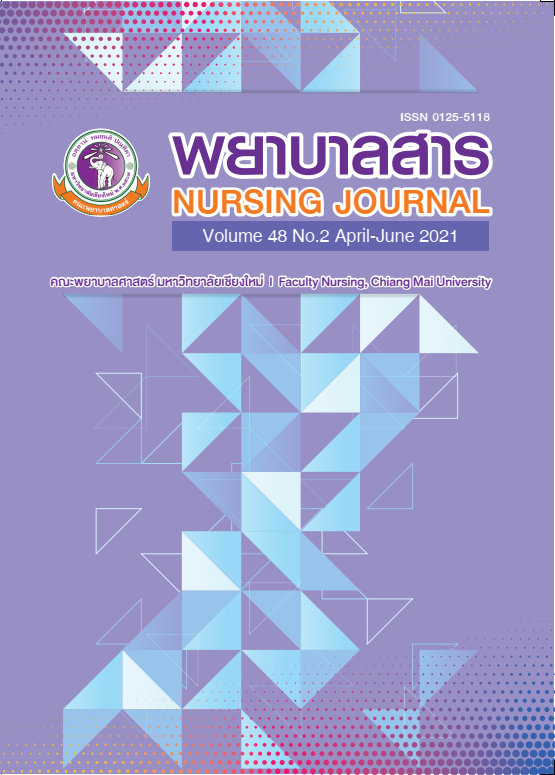Web Application Development for Postdischarge Surgical Site Infection Surveillance
Keywords:
Web application, Surgical Site Infection, Surveillance, Post-discharge PatientAbstract
It is estimated that 23-44% of surgical site infections (SSIs) are detected after the patient is discharged. Effective post-discharge surveillance methods should be developed to obtain accurate SSI rates. This developmental research study aimed to develop a web application for post-discharge SSI surveillance and to study the effectiveness of the web application. The sample included 42 patients undergoing major surgery in a regional hospital. The web application was developed and data were collected between November 2017 and March 2018. The research instruments consisted of two parts: demographic data questionnaire and the web application for post-discharge SSI surveillance which included a SSI surveillance form and a satisfaction questionnaire. These instruments were validated by five content experts. The content validity index of the SSI surveillance form and web application satisfaction questionnaire were 1.0 and the reliability were 1.0 and .89 respectively. The effectiveness of the web application for post-discharge SSI surveillance was tested using one to one, small groups, and field tests. Data were analyzed using descriptive statistics.
The web application developed for post-discharge SSI surveillance consisted of two parts. The first part was the web frontend which included user login, demographic data, the SSI surveillance form, knowledge on assessment and care for surgical wound, summary of SSI signs and symptoms, surgical wound photos and communication with a healthcare provider, the web application satisfaction questionnaire, the user manual, duration of SSI surveillance and log out. The second part was a web application backend for administrator use which included information on the administrator, users, summary of patient data, daily summary of patient data, summary of web application satisfaction questionnaire, summary of SSI signs and symptoms and log out. The web application was found to be effective as all participants provided information on SSI signs and symptoms and all participants with SSO symptoms were diagnosed within 24 hours. Overall, user satisfaction for the web application was high to very high with regards to content (mean 4.40 – 4.51), design and presentation (mean 4.14 – 4.51), usability (mean 4.33 – 4.62) and overall satisfaction (mean 4.55).
The results of the study show that the web application for SSI surveillance was effective and could be used for post-discharge SSI surveillance to obtain complete information and accurate SSI rates. In addition, patients with SSI were detected early and quickly treated.
References
Centers for Disease Control and Prevention. (2013). CDC/NHSN protocol clarifications. Retrieved from https:// www.cdc.gov/nhsn/pdfs/pscmanual/pcsmanual_current.pdf.
Cybulski, E., Erickson, A., Falco, J., Ingersol, C., & Kumi, E. (2014). Hospitals Battling to Reduce Readmission Due to Surgical Site Infections. Retrieved from http://www.slideshare.net/EricCybulski/ssi-final-51703770
Eamsiriwong, O. (2002). Analysis and design a system. Bangkok: SE-ED.
Kasatpibal, N., Nørgaard, M., & Jamulitrat, S. (2009). Improving surveillance system and surgical site infection rates through a network: A pilot study from Thailand. Clinical epidemiology, 1, 67-74.
Mangram, A. J., Horan, T. C., Pearson, M. L., Silver, L. C., Jarvis, W. R., & Hospital Infection Control Practices Advisory Committee. (1999). Guideline for prevention of surgical site infection, 1999. American Journal of Infection Control, 27(2), 97-134.
Martinez-Pere, B., Tone-Diez, I., & Lopez-Coronado, M. (2015). Privacy and security in mobile health apps: a review and recommendations. Journal of Medical Systems, 39, 181.
Sanger, P. C., Hartzler, A., Lober, W. B., Evans, H. L., & Pratt, W. (2014). Design considerations for post-acute care mHealth: Patient perspectives. In Proceedings of AMIA Annual Symposium, 1920-1929.
Sanger, P. C., Hartzler, A., Lorrdon, R. J., Armstromg, C.A., Lober, W. B., Evans, H. L., & Pratt, W. (2016). A patient-centeres system in a provider-centered world: challenges of incorporating post discharge wound data into practice. Journal of American Medical Association, 23, 514-525.
Semple, J. L., Sharpe, S., Murnaghan, M. L., Theodoropoulos, J., & Metcalfe, K. A. (2015). Using a mobile app for monitoring post-operative quality of recovery of patients at home: a feasibility study. JMIR mHealth and uHealth, 3(1), 18-21.
Shepard, J., Ward, W., Milstone, A., Carlson, T., Frederick, J., Hadhazy, E., & Perl, T. (2013). Financial impact of surgical site infections on hospitals: the hospital management perspective. Journal of the American Medical Association of Surgery, 148(10), 907-914.
Sparks, E. K., Lorden, R., Hartzler, A., Whitney, J., Evans, H., & Lober, W. (2016). Patient-generated serial photos of surgical wounds following discharge to guide clinical decision making. Retrieved from http://c.ymcdn.com/sites/siim.org/resource/resmgr/siim2016abstracts/Poster_Demo_Sparks.pdf.
Suwannakeeree, W., & Payaprom, Y. (2017). Prevention of surgical site infection. Nursing Journal, 29(2). 15-28.
World Health organization. (2015). Size and distribution of the global volume of surgery in 2012. Retrieved from http://www.who.int/bulletin/volumes/94/3/15-159293/en.
Downloads
Published
How to Cite
Issue
Section
License
บทความที่ได้รับการตีพิมพ์เป็นลิขสิทธิ์ของวารสารพยาบาลสาร
ข้อความที่ปรากฏในบทความแต่ละเรื่องในวารสารวิชาการเล่มนี้เป็นความคิดเห็นส่วนตัวของผู้เขียนแต่ละท่านไม่เกี่ยวข้องกับมหาวิทยาลัยเชียงใหม่ และคณาจารย์ท่านอื่นๆในมหาวิทยาลัยฯ แต่อย่างใด ความรับผิดชอบองค์ประกอบทั้งหมดของบทความแต่ละเรื่องเป็นของผู้เขียนแต่ละท่าน หากมีความผิดพลาดใด ๆ ผู้เขียนแต่ละท่านจะรับผิดชอบบทความของตนเองแต่ผู้เดียว






